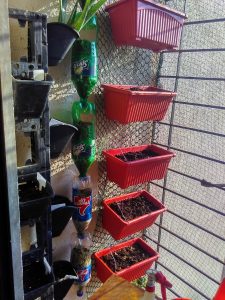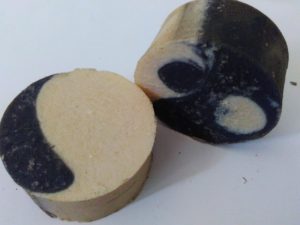People often ask me for advice on gettting started making handmade soaps. Collecting some common questions and answers here.
Where to get ingredients?
The short answer is online. Any of the Amazon, Flipkart, Ebay type places will usually have everything you need to get started making soaps. This should be adequate if you are just curious and making as an experiment or for personal use. If you want to make soaps as a business, you should approach wholesalers – you should do your own research here. If there are specific items you find hard to procure, feel free to ping me, and I’ll share what information I have.
I only want to cold process soaps as a hobby. Is it okay if I don’t have a weighing scale?
I get asked this question routinely and in creative ways, as though if it is asked in the magic way, the answer will be yes. Nope. No. NO. It is next to impossible to make a good cold process soap without weighing out your ingredients carefully. If you eyeball it, you will at best end up with a good soap you cannot replicate (trust me, this is not very likely) or you could end up with a soap that gives you chemical burns and is not safe to use. Less extreme options include a soap that is too oily to lather well.
But I don’t have a weighing scale and I want to make soap.
Buy melt and pour soap base. Melt it, pour it, let it solidify. If you don’t have a weighing scale, don’t make cold process soap. You will regret.
Is it worth it to make cold process handmade soaps for personal use?
Not really. If you absolutely must make soap for personal use, stick to melt and pour soaps. The kind of investment you will end up making in ingredients, colorants, oils, fragrances and so on will cost way more than cost of buying several years supply of high quality soap made by an experienced soapmaker. The quality will be better than a beginner’s learning curve. You will just end up spending on and accumulating a lot of things. At the end of the day, there’s just so much you can bathe and it isn’t so much fun to gift till you get better at it.
What is a good way to try out making handmade soaps?
See if you can attend a class to learn to make them. Alternatively, you can befriend a soapmaker and ask to visit and help or observe when they make soap. You will benefit from being a part of the process by an experienced artist, as well as get exposure to a lot of ingredients and equipment you likely won’t get around to buying as a beginner. I had someone come over and learn in exchange for handling the clean up of the process (which I hate). I discussed the recipe and technique I was planning with them, then they were present and helping out during the process as per my instructions (mixing colors, etc) and were able to pour a small batch of soap for themselves after watching how I did it.
Both methods have their advantages and disadvantages. Attending a class to learn may cover the basics better. Participating in actual production of soap intended for sale is likely to result in exposure to advanced techniques. That said, this isn’t a rule. Some classes may teach different techniques or a soap batch for sale may be relatively simple to make.
How easy is it to make handmade soaps commercially?
Frankly, it depends on your ability to sell. If you are able to sell the soaps you make, you will be successful. Otherwise, not so much. Assuming you are able to sell, quantity will result in profits. Then there is the question of aesthetics and quality. If your soaps have a unique appeal, they will result in dedicated customers. Generally, with bulk manufactured commercial soap being inexpensive, it is difficult to justify the higher expense of handmade soap unless the buyer can immediately see the appeal and experience the quality when in use.
Another thing that leads to success is offering customization that commercial soaps can’t. I have some buyers who want vegan soaps. One specifically wants plain unscented soap – no additives. They come to me because they can specifically ask for recommendations based on their preferences, or they can ask me to make a batch of soap to their specifications.
I make artistic soaps, mostly and sell only on this site. Nowhere else. I don’t do this full time and it does not result in enough profit to make a living. This is more an artistic passion that pays for itself (rather than me). If I had to turn this into a commercial success, I’d have to ramp up production – bigger batches, more often AND I would have to either sell in bulk to other retailers or I would have to enter marketplaces with volume like Amazon or Etsy and such.
What is the easiest way to make a soap for personal use?
I would recommend two ways. Soap clays and melt and pour soap. First – and it is not easily available – is if you get access to soap “clay”. This is properly made soap, that is not hardened off and is the consistency of clay. You can simply shape it as you wish, let it dry and harden and use it. This is good, because you can literally do it without having any specialized equipment. This can also be fun for children to make their own soap and most clay working tools can be used to shape the soap. Downside: I don’t know anyone who sells soap clay commercially in India. I am planning to, but haven’t got around to doing it yet. Do comment if you’d like to buy some.
Melt and pour soap is soap that has been made using the hot process method and has solvents added that can make it transparent in addition to allowing it to become liquid when heat is applied. You can melt it in a double boiler or microwave and pour it into a suitable mould. Downside: creating art in such soap is pretty much limited to layers and embeds. There is limited potential to swirl colors, but you have nowhere near the control you have with cold process soap or malleability of soap clay.
Hope this helps. I’ll add more questions when I go through my emails.
[ngg src=”galleries” ids=”4″ display=”basic_thumbnail”]







